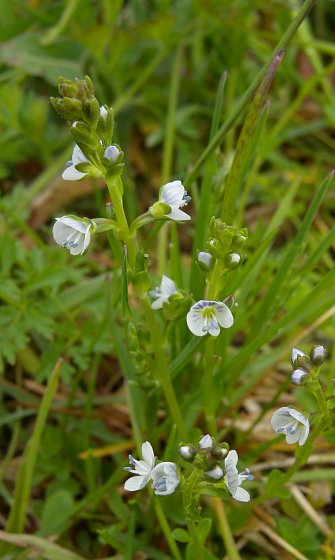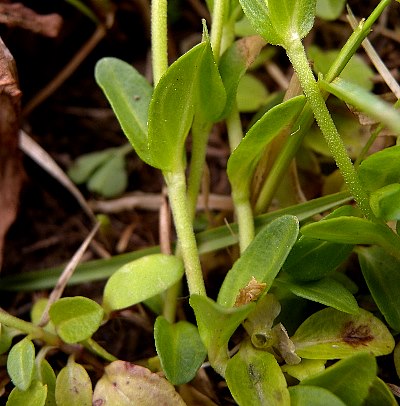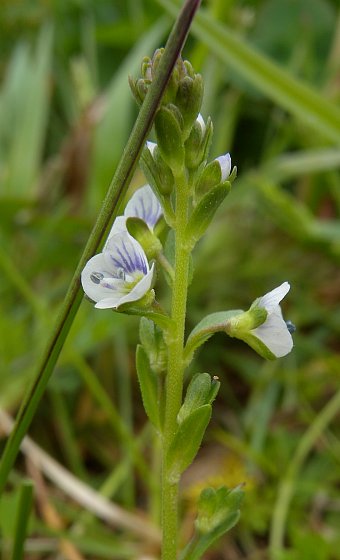Description: This perennial wildflower is 4-12" tall, producing several unbranched stems from its base. Individual stems are decumbent initially, but they become more erect when the flowers are produced. Each slender stem is light green, terete, and sparsely to moderately covered with fine appressed hairs. Pairs of opposite leaves occur along each stem. Early leaves have winged petioles, but later leaves are sessile. The blades of the leaves are ¼-¾" long and about one-half as much across; they are medium green, elliptic-oblong to oval in shape, smooth or slightly crenate along their margins, and glabrous. Each upper stem terminates in a narrow raceme of flowers about 2-7" long. Individual flowers are produced in pairs or alternately along the raceme on short slender petioles up to ¼" long. At the base of each flower, there is a leafy bract that is the same length or a little longer than the petiole; each bract is elliptic or oblong in shape, smooth along the margin, and glabrous.

Individual flowers
are about ¼" across, consisting of a short corolla with 4 rounded
lobes, a short green calyx with 4 teeth, 2 stamens with white filaments
and blue anthers, and a green ovary with a single style. The corolla is
usually white (less often pale blue) with dark blue veins; the lowest
lobe of the corolla is smaller in size than the lateral and upper
lobes. The blooming period occurs primarily from mid-spring to early
summer for about 2 months; some plants will bloom later than this if a
disturbance damages their stems. The flowers are diurnal and lack
significant fragrance. Each flower is replaced by a 2-celled seed
capsule about ¼" across that is obcordate and somewhat flattened. At
maturity, each capsule splits open to release numerous tiny seeds.
These seeds are small enough to be blown about by the wind. The root
system is fibrous and rhizomatous. Colonies of plants are often
produced at favorable sites.
Cultivation:
The preference is full sun to light shade and moist to mesic
conditions. Different kinds of soil are tolerated, including those that
contain loam, clay, sand, or silt. Most growth and development occur
during the cool rainy weather of spring.

Range &
Habitat:
Thyme-Leaved Speedwell is scattered across Illinois, although it is
more common in the northern half of the state than the southern half
(see Distribution
Map). This non-native species was introduced into North
America from Europe.
Habitats consist of meadows, lawns, grassy areas of parks, and low
areas along ponds, rivers, and springs. These habitats are usually
disturbed and semi-shaded.
Faunal Associations:
Very little is specifically known about floral-faunal relationship for
this species. The flowers are cross-pollinated by flies and small bees
(e.g., Syrphid flies, blow flies, and Halictid bees). These insect
obtain primarily nectar from the flowers. In limited amounts, the
foliage is not particularly toxic to vertebrate animals; it is probably
eaten by the Cottontail Rabbit, Groundhog, and Canada Goose. The flat
tiny seeds can cling to the feathers of birds, fur of mammals, and
shoes of humans; this method of locomotion helps to spread the seeds
into new areas.

Photographic
Location:
A lawn near Grand Rapids, Ohio.
Comments:
This small wildflower is one of several weedy Veronica spp.
that have been introduced from Europe. Because of its small stature, it
is not often noticed except when sizeable colonies of flowering plants
are in bloom. Such colonies can produce an attractive display in lawns
as the flowers are usually held above the blades of grass. Thyme-Leaved
Speedwell can be distinguished from other Veronica spp.
by its terminal racemes of flowers; it does not produce axillary
racemes of flowers, nor does it produce individual flowers from the
axils of true leaves (as opposed to the smaller leafy bracts). The leaf
blades of Thyme-Leaved Speedwell are less toothed than those of many
introduced Veronica spp., and it is a smaller plant
than most native Veronica spp. While the native Veronica
peregrina (Purslane Speedwell) is no larger than Thyme-Leaved
Speedwell, the former species has flowers that are more white and its
stems are hairless.